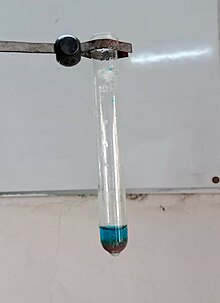Barfoed's test
 Positive result in Barfoed's test | |
| Classification | Colorimetric method |
|---|---|
| Analytes | Monosaccharides |
Barfoed's test is a chemical test used for detecting the presence of monosaccharides. It is based on the reduction of copper(II) acetate to copper(I) oxide (Cu2O), which forms a brick-red precipitate.[1][2]
- RCHO + 2Cu2+ + 2H2O → RCOOH + Cu2O↓ + 4H+
(Disaccharides may also react, but the reaction is much slower.) The aldehyde group of the monosaccharide which normally forms a cyclic hemiacetal is oxidized to the carboxylate. A number of other substances, including sodium chloride,[3] may interfere.
Its autor is the Danish chemist Christen Thomsen Barfoed[1] and is primarily used in botany.[citation needed]
The test is similar to the reaction of Fehling's solution to aldehydes.
Composition
[edit]Barfoed's reagent consists of a 0.33 molar solution of copper (II) acetate in 1% acetic acid solution.[4] The reagent does not keep well and it is therefore advisable to make it up when it is actually required.[5]
Procedure
[edit]1 drops of Barfoed's reagent is added to 2 mL of given sample in a test tube and boiled for 3 minutes and then allowed to cool. If a red precipitate occurs, a monosaccharide is present.
References
[edit]- ^ a b C. Barfoed (1873). "Über die Nachweisung des Traubenzuckers neben Dextrin und verwandten Körpern". Fresenius' Zeitschrift für Analytische Chemie. 12 (1): 27. doi:10.1007/BF01462957. S2CID 95749674.
- ^ Biochemistry Department. "Colorimetric Identification of Unknown Sugars". Biochemistry Laboratory 353. Smith College. Archived from the original on 2006-07-16.
- ^ William H. Welker (1915). "A Disturbing Factor in Barfoed's Test". J. Am. Chem. Soc. 37 (9): 2227–2230. doi:10.1021/ja02174a036.
- ^ "Barfoed Reagent Safety Data Sheet" (PDF). Broward Central Science. Carolina Biological Supply Company. Archived from the original (PDF) on 14 February 2020. Retrieved 10 September 2020.
- ^ Bowen, Graham and Williams (1957). A Students' Handbook of Organic Qualitative Analysis. University of London Press. p. 73.
